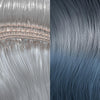
The cuticle – Key to shine, protection & structure
3 min reading time

3 min reading time
Discover why the cuticle is the most important part of your hair. Learn how this outer layer provides shine, protection, and lasting health.
The importance of the cuticle – protection, shine and structure
The cuticle , the outermost layer of the hair, appears microscopic, but it largely determines the health, shine, and resilience of the hair fiber. This layer acts as the hair's armor . An intact cuticle reflects light, retains moisture, and protects the cortex from damage. For professionals, understanding the cuticle is essential to perform every treatment scientifically and safely.
1. What exactly is the cuticle?
The cuticle consists of 6 to 10 layers of overlapping cells , similar to roof tiles.
✔ They protect the inner layers from heat, UV, chemicals and friction.
✔ They regulate moisture exchange between hair and the environment.
✔ They determine the degree of gloss by reflecting light.
When these cells are tightly packed, hair feels soft. When they are open, it feels rough, dry, and porous.
2. The role of the cuticle in shine and protection
The cuticle acts like a mirror. When the cells lie flat, light reflects in one direction – the hair shines.
✔ Closed cuticle = shine, softness and resistance.
✔ Damaged cuticle = dull, frizzy and brittle hair.
The natural lipid layer (especially 18-MEA) keeps the scales supple. Chemical or thermal treatments destroy this layer, making the hair more fragile.
3. Factors that damage the cuticle
✔ Excessive use of heat tools above 180°C.
✔ Chemical treatments without pH neutralization.
✔ Hard water (minerals that build up on the hair).
✔ Sun, wind and chlorine.
✔ Incorrect brushing or too rough towel drying.
Each of these factors roughens the surface – the scales “open up” and lose their protective function.
4. How do you repair the cuticle?
Professional hair care focuses on closing, strengthening and protecting this layer.
✔ Use acidic products (pH 4.5–5.5) to close the scales.
✔ Treat regularly with amino acids and hydrolyzed keratin .
✔ Add lipids or oils (such as argan or macadamia) to restore the natural film.
✔ Avoid aggressive sulphates – they strip the protective layer of fat.
The goal: to keep the cuticle as smooth and resilient as possible.
5. Why the cuticle determines color and styling
A damaged cuticle allows color pigments to escape and makes coloring unpredictable.
✔ Closed scales retain pigment and hydration.
✔ Open scales lead to uneven absorption and faster fading.
With heat treatments, the condition of the cuticle determines whether the hair tolerates the heat well. Therefore, a cuticle assessment is a crucial first step before any treatment.
6. Professional innovations for cuticle protection
✔ Nanoplastia & Hair Botox – close the scales with amino acids and oils.
✔ Plex systems – strengthen the bonds between cuticle and cortex.
✔ pH-balance sprays & sealing masks – ensure long-lasting smoothness.
These technologies combine science with results: shine on the outside, recovery on the inside.
Conclusion: the cuticle is small, but crucial
Protecting the cuticle protects the entire hair strand. This thin, almost invisible layer is the difference between temporarily beautiful and permanently healthy. For professionals, understanding, analyzing, and treating the cuticle is the core of any successful hair treatment .